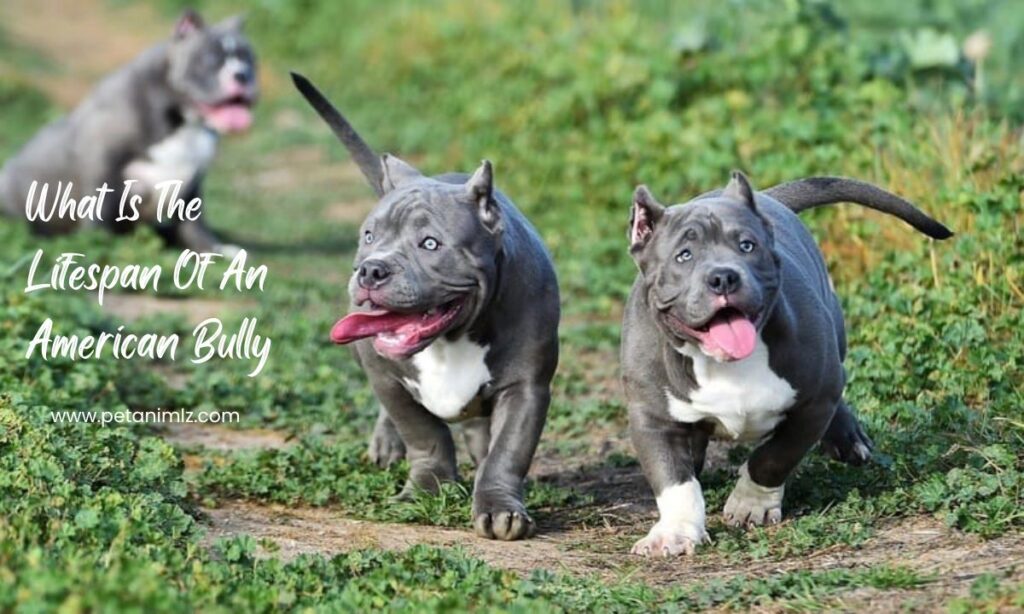What Is The Lifespan Of An American Bully: How Long Do They Really Live?
Introduction To The Lifespan Of An American Bully
In this article, the lifespan of an American bully has been mentioned. The American Bully, a breed known for its muscular build and affectionate nature, has gained popularity among dog enthusiasts worldwide. But one question that often arises is, how long do these majestic creatures typically live? On average, an American Bully boasts a lifespan ranging from 10 to 12 years. However, this isn’t a fixed number set in stone. Several factors, some within our control and others not, can influence this duration, either extending it or, unfortunately, shortening it.
Just like humans, where genetics, lifestyle, and healthcare play a role in our longevity, similar factors come into play for the American Bully. The breed’s lineage, the care it receives, its diet, exercise routine, and even its environment can all have a significant impact on its lifespan.
For potential American Bully owners or those who already have one as part of their family, understanding these factors is crucial. It not only helps in setting realistic expectations but also guides owners in providing the best care possible, ensuring that their furry friend lives a long, healthy, and fulfilling life.
In this article, we’ll embark on a journey to explore the various elements that determine the lifespan of an American Bully. We’ll delve deep into the intricacies of genetics, the importance of a balanced diet and regular exercise, the role of timely medical care, and the influence of the dog’s living environment. So, if you’re curious to know more about what affects the lifespan of your American Bully and how you can potentially extend it, read on. This comprehensive guide aims to provide insights and tips to ensure your bully lives its best life.

What Is An American Bully
Before going to discuss the Lifespan Of An American Bully first overview of American Bully. The American Bully is a relatively new breed of dog, established in the late 20th century. It was developed as a companion dog from breeds that are now widely recognized as being among the most human-oriented of all dogs. Here’s a detailed overview:
- Origin and Development:
- The American Bully was developed in the 1980s and 1990s in the United States. It was primarily bred from the American Pit Bull Terrier and the American Staffordshire Terrier, with influences from other breeds such as the English Bulldog, Olde English Bulldogge, and possibly the French Bulldog.
- Appearance:
- The American Bully is a muscular and compact dog. They have a broad head, short muzzle, and a sturdy bone structure. Their coat is short, glossy, and can come in a variety of colors.
- There are several size categories of the American Bully: Pocket, Standard, Classic, and XL. Each has specific height and weight requirements.
- Temperament:
- Contrary to some misconceptions, the American Bully was bred to be a companion dog and has a temperament suited for that purpose. They are known to be affectionate, loyal, and extremely friendly, especially with their families.
- They are generally good with children and can be very protective of their family members.
- While they can be friendly with strangers and other animals, early socialization is crucial to ensure a well-rounded temperament.
- Health:
- Like all breeds, American Bullies can be prone to certain health issues. Common concerns include hip dysplasia, heart problems, and skin issues.
- Regular check-ups, a balanced diet, and proper exercise can help in ensuring a healthy life for the dog.
- Care and Maintenance:
- They require regular exercise to keep them fit and healthy but are not as hyperactive as some other breeds.
- Their short coat is relatively easy to maintain, requiring regular brushing to remove loose hairs and occasional baths.
- Popularity and Controversy:
- The breed has gained significant popularity in recent years, especially in the United States. However, it has also faced controversy due to its association with the American Pit Bull Terrier, a breed that has been banned or restricted in many places. It’s essential to differentiate between the American Bully, which is bred primarily as a companion dog, and other breeds that may have been bred for fighting in the past.

Is An American Bully Aggressive Behaviors
The American Bully, as a breed, is not inherently aggressive. In fact, the breed was developed to be a companion dog with a friendly and sociable temperament. However, like any dog breed, individual temperament can vary, and behavior is often a result of genetics, upbringing, training, and socialization. Here are some points to consider:
- Breed Temperament:
- The American Bully is known for its loyalty, affection, and desire to please its owners. They are generally good with children and can be protective of their family members.
- They are typically friendly with strangers, especially when properly socialized from a young age.
- Factors Influencing Aggression:
- Poor Socialization: Dogs that are not exposed to various people, places, and other animals during their formative weeks and months can develop fear-based aggression.
- Training and Upbringing: Dogs that are mistreated, abused, or trained using harsh methods can develop aggressive behaviors.
- Health Issues: Pain or medical conditions can cause a dog to become irritable or aggressive.
- Genetics: While the breed standard emphasizes a friendly temperament, individual dogs might inherit aggressive tendencies from their parents.
- Misconceptions and Stereotypes:
- Due to their muscular appearance and association with breeds like the American Pit Bull Terrier, American Bullies can sometimes be mistakenly labeled as aggressive. This stereotype is often unfounded and can lead to prejudice against the breed.
- It’s essential to differentiate between the American Bully, which is bred primarily as a companion dog, and other breeds or individual dogs that may have been bred or trained for fighting.
- Prevention and Training:
- Early socialization is crucial. Exposing puppies to various people, animals, and environments can help them grow into well-adjusted adults.
- Positive reinforcement training methods are recommended. Rewarding good behavior rather than punishing undesirable behavior is more effective and fosters a positive human-dog bond.
- If signs of aggression or behavioral issues are noticed, it’s essential to consult with a professional dog trainer or behaviorist to address the problem early on.
In conclusion, while the American Bully as a breed is not inherently aggressive, individual dogs, like those of any breed, can develop aggressive behaviors based on various factors. Proper training, socialization, and care can ensure that an American Bully grows up to be a well-behaved and loving companion.
Factors Influencing the Lifespan of an American Bully
Genetics
Genetics undeniably play a pivotal role in determining the lifespan of an American Bully.
- Importance of Lineage: Just like in humans, a dog’s lineage can significantly impact its overall health and Lifespan Of An American Bully. Dogs from a robust and healthy lineage tend to live longer and face fewer health issues.
- Role of Reputable Breeders: It’s imperative to choose breeders with a reputation for prioritizing the health and genetics of their dogs. These breeders often ensure that their dogs are free from genetic defects that could shorten their lifespan.
- Genetic Testing: This is an invaluable tool in the world of dog breeding. Genetic testing helps identify potential genetic disorders, ensuring that only the healthiest dogs are bred.
Nutrition & Exercise
The saying “You are what you eat” holds for dogs too.
- Balanced Diet: A balanced diet is paramount for maintaining the dog’s health and preventing potential diseases. It ensures they get all the necessary nutrients for a healthy life.
- Regular Exercise: Exercise is not just about maintaining weight. It’s crucial for cardiovascular health, muscle building, and overall well-being.
Medical Care
Timely and appropriate medical care can significantly extend a dog’s life.
- Routine Check-ups and Vaccinations: Regular visits to the vet and timely vaccinations can prevent many potential health issues.
- Early Detection: Detecting health issues early on can make a world of difference in treatment outcomes.
- Preventive Care: This is not just about treating diseases but preventing them. Proper preventive care can significantly extend the bully’s life.
Environmental Factors
The environment in which a dog lives can have a profound impact on its health and Lifespan Of an American Bully.
- Living Conditions: Clean, safe, and stimulating environments contribute to longer, healthier lives.
- Mental Stimulation and Social Interaction: Just like humans, dogs need mental stimulation and social interactions to stay happy and healthy.
- Potential Hazards: Awareness of potential hazards in the environment, like toxic plants or unsafe areas, is crucial.
How To Ensure Your American Bully Lives A Long Health Life
Ensuring that your American Bully lives a long and healthy life involves a combination of proper care, regular medical check-ups, a balanced diet, and mental stimulation. Here are some steps and guidelines to help your American Bully thrive:
- Balanced Diet:
- Feed your American Bully high-quality dog food that meets their nutritional needs. Ensure it’s appropriate for their age, size, and activity level.
- Avoid overfeeding. Obesity can lead to various health issues, including joint problems and heart disease.
- Provide fresh water at all times.
- Regular Exercise:
- While American Bullies are not as hyperactive as some breeds, they still need regular exercise to maintain a healthy weight and muscle tone.
- Engage in daily walks, play sessions, and other physical activities that your dog enjoys.
- Ensure they have a safe space to run and play, whether it’s a backyard or a local dog park.
- Routine Veterinary Care:
- Schedule regular check-ups with a veterinarian to catch and address potential health issues early.
- Keep up with vaccinations, flea and tick prevention, and deworming.
- Monitor for signs of common health issues in the breed, such as hip dysplasia or skin problems.
- Mental Stimulation:
- Just like physical exercise, mental stimulation is crucial for your dog’s overall well-being.
- Engage in training sessions, provide puzzle toys, and introduce new games or activities to keep their mind sharp.
- Proper Socialization:
- Expose your American Bully to various people, animals, and environments from a young age. This helps in preventing behavioral issues and ensures they are well-adjusted.
- Enroll in puppy classes or socialization groups if possible.
- Grooming:
- Regularly brush your American Bully to remove loose hairs and keep their coat healthy.
- Check their ears, eyes, and teeth regularly. Dental hygiene is essential, so consider brushing their teeth or providing dental chews.
- Safe Environment:
- Ensure your home and yard are safe for your dog. This includes securing trash, removing toxic plants, and ensuring there are no escape routes.
- Be cautious with extreme temperatures. American Bullies, with their short coats, can be sensitive to excessive cold or heat.
- Training:
- Use positive reinforcement techniques. Rewarding good behavior is more effective than punishing bad behavior.
- Establish clear boundaries and be consistent with training.
- Regular Monitoring:
- Pay attention to any changes in behavior, appetite, or physical appearance. These could be signs of underlying health issues.
- Address any concerns with your veterinarian promptly.
- Love and Attention:
- Spend quality time with your American Bully. Affection, bonding, and companionship are vital for their emotional well-being.
By following these guidelines and being proactive in your dog’s care, you can significantly increase the chances of your American Bully living a long, healthy, and happy life.
FAQs
How long do most American Bullies live?
Typically, they live between 10 to 12 years, but this can vary based on several factors.
What can owners do to extend their bully’s lifespan?
Proper care, a balanced diet, regular exercise, and timely medical care are key.
Are there any common health issues that can shorten their life?
Yes, like all breeds, they have specific health concerns, but with proper care, these can be managed.
How do genetics play a role in their lifespan?
Genetics can determine predispositions to certain health issues, affecting the overall Lifespan Of an American Bully.
How long does an American Bully live?
The American Bully typically has a lifespan of 8 to 13 years. However, with proper care, regular check-ups, and a healthy diet, some can live longer.
How long do American pocket bullies live?
American Pocket Bullies, a subtype of the American Bully, generally have a similar lifespan to the standard American Bully, which is around 8 to 13 years. Their lifespan can be influenced by factors such as genetics, health care, diet, and exercise.
Which dog lives longest?
Small dog breeds tend to live longer than larger breeds. The Chihuahua, Dachshund, and Toy Poodle are among the breeds that often have longer lifespans, with many living into their late teens. However, the specific dog that holds the record for the longest lifespan ever recorded is “Bluey,” an Australian Cattle Dog, who lived for 29 years and 5 months.
How smart is an American Bully?
The American Bully is known for its loyalty, affection, and intelligence. While they might not rank at the very top in terms of working intelligence (like Border Collies or Poodles), they are quick learners, especially when training involves positive reinforcement. Their intelligence combined with their desire to please their owners makes them relatively easy to train.
Are Bully dogs lazy?
American Bullies are generally laid-back and can be couch potatoes, but they also enjoy playtime and exercise. While they might not have the same energy levels as some high-energy breeds, they still require regular exercise to keep them healthy and prevent obesity.
Are American Bullies good or bad?
The temperament of an American Bully is typically friendly, affectionate, and sociable. They are known to be great with children and can be excellent family pets. However, like any dog breed, their behavior largely depends on their upbringing, training, and socialization. A well-raised and trained American Bully can be a wonderful companion. It’s essential to remember that no breed is inherently “bad”; it’s often the result of poor training or mistreatment
Conclusion
In conclusion, the lifespan of an American Bully is influenced by a myriad of factors, from genetics to the environment they live in. Proper care, nutrition, and medical attention are paramount for ensuring a long and healthy life. For potential and current American Bully owners, it’s essential to stay informed and proactive, ensuring your furry friend gets the best life possible.





